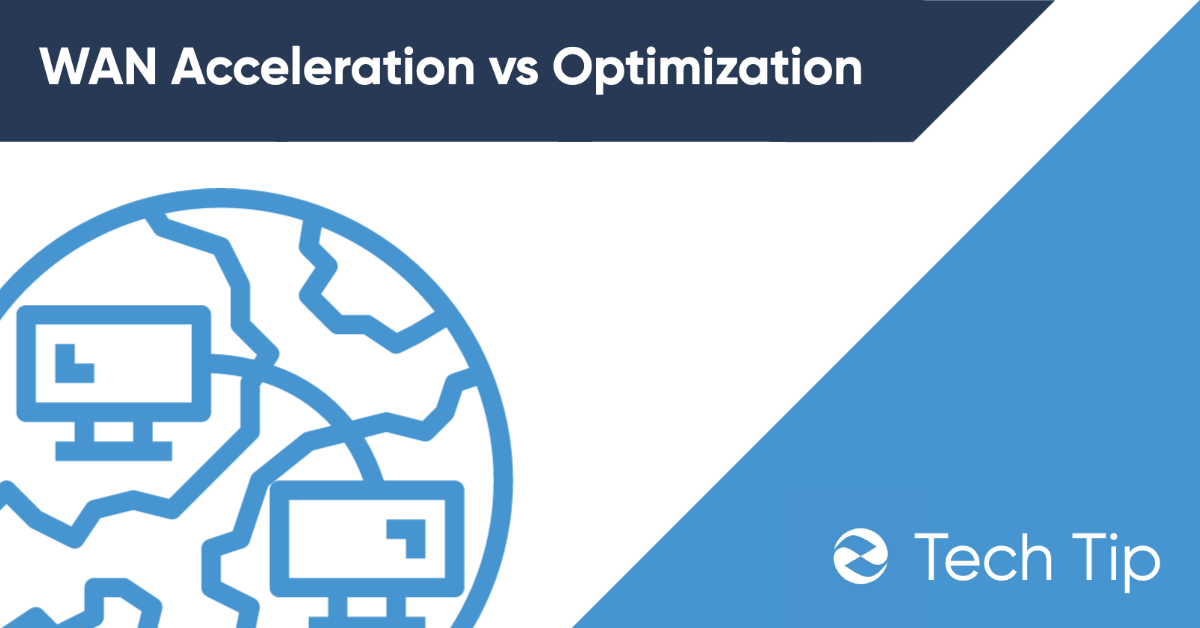WAN Acceleration vs WAN Optimization

You may have come across the terms “WAN acceleration” and “WAN optimization.” These are two techniques used to improve the performance of data transfers over a wide area network (WAN), which can be slow and prone to latency issues. WAN acceleration is often a component of WAN optimization so you would likely use both together.
While often regarded as interchangeable terms, there is a difference. The main difference between WAN acceleration and WAN optimization lies in the approach they take to improving network performance. WAN acceleration is primarily concerned with reducing the amount of data that needs to be transmitted over the network. This is achieved by compressing data, deduplicating it, and using caching techniques to store frequently accessed data closer to the end-user. These techniques help to minimize the amount of data that needs to be transmitted over the WAN, thereby reducing latency and improving performance.
On the other hand, WAN optimization takes a more holistic approach to network optimization. In addition to reducing the amount of data that needs to be transmitted, WAN optimization also focuses on improving network efficiency through techniques such as packet shaping, TCP optimization, and application performance management. By addressing the underlying causes of network latency and improving overall network efficiency, WAN optimization can provide more significant improvements in network performance than WAN acceleration alone.
WAN Acceleration in Detail
WAN acceleration is a technology that is designed to improve the performance of data transfers over a wide area network (WAN). It achieves this by reducing the amount of data that needs to be transmitted over the network, thereby minimizing latency and improving overall performance.
Here’s a few ways WAN Acceleration can be used:
Data compression: This technique compresses the data that is being transmitted, reducing the size of the data packets, and enabling them to be transmitted more quickly over the network. This is particularly useful when dealing with large files, such as video or image files, which can take a long time to transfer over a WAN.
Deduplication: This involves identifying and removing duplicate data packets, which can occur when multiple users are accessing the same file or data. By removing these duplicates, WAN acceleration reduces the amount of data that needs to be transmitted, improving performance, and reducing latency.
Caching: Caching this involves storing frequently accessed data closer to the end-user, such as on a local server or in a cloud-based storage system. By caching data in this way, WAN acceleration reduces the amount of data that needs to be transmitted over the WAN, improving performance, and reducing latency.
Example?
A remote office setting is the perfect example of how a business can leverage WAN acceleration. In this scenario, employees in a remote office may need to access files and applications that are stored on a central server located in a different location. WAN acceleration can be used to reduce the amount of time it takes for these files and applications to load by compressing the data and caching frequently accessed data closer to the end-user.
WAN Optimization in Detail:
WAN optimization is a technology that takes a more comprehensive approach to network optimization than WAN acceleration. In addition to reducing the amount of data that needs to be transmitted over the network, WAN optimization focuses on improving overall network efficiency through techniques such as packet shaping, TCP optimization, and application performance management.
Here’s a few ways WAN optimization can be used:
Packet Shaping: a technique used in WAN optimization to prioritize network traffic based on the type of data being transmitted. This allows important data, such as mission-critical applications, to be prioritized over less important data, such as email or web browsing traffic. By prioritizing traffic in this way, WAN optimization can help to reduce latency and improve overall network performance.
TCP Optimization: TCP is the protocol used to transmit data over the internet, but it can be prone to issues such as packet loss and retransmission. WAN optimization can help to address these issues by optimizing the way that TCP packets are transmitted over the network. This can help to reduce latency and improve overall network performance.
Application Performance Management: This involves monitoring the performance of applications running over the network and making adjustments to optimize their performance. For example, WAN optimization may adjust the bandwidth allocated to a particular application or optimize the way that data is transmitted to improve its performance.
Example of WAN Optimization
WAN optimization is excellent for large corporate networks.
In corporate networks, the network may have multiple branches or remote offices that are connected to a central data center. WAN optimization can be used to improve overall network performance by prioritizing traffic based on the type of data being transmitted, optimizing the way that TCP packets are transmitted, and monitoring and optimizing the performance of applications running over the network.
Which Approach is Better?
If you’re dealing with limited bandwidth and high latency, WAN acceleration may be the best option as it can reduce the amount of data that needs to be transmitted over the WAN, improving overall performance. However, if your network is plagued by other issues such as packet loss or poor application performance, WAN optimization may be the better choice as it can address these underlying issues and provide more comprehensive performance improvements.